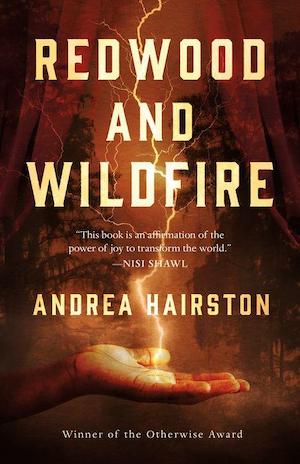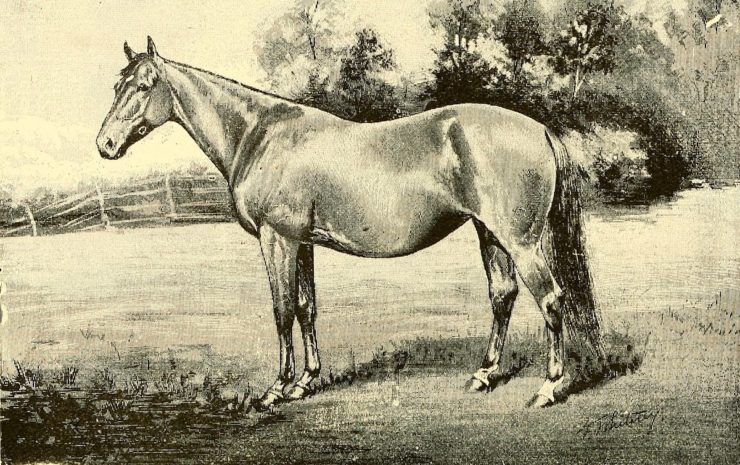Every gardener in a temperate climate knows that winter is the fallow season, but it’s also the season of hope. That’s when the seed catalogues start to arrive. The garden is asleep, but once the days start to lengthen, it won’t be too terribly long before it’s time to till and plant.
The same thing happens to horse breeders. With a gestation period of 345 days on the average—eleven months and a week is the rule of thumb for calculating the approximate due date—waiting for a foal can seem like an eternity. The mare goes on about her business for the most part, but sooner or later, she’ll start to show signs that something is going on in there. She may barely round out, or she may become so spherical that observers wonder how she stays up on those spindly legs.
As for how she got to this point, it all began well over a year ago. Horse breeding in our modern era is seldom a random or accidental process. There will be the occasional Oops (stallion goes over or through the fence, mare tries the same maneuver, farm manager does not stop to think that the Mini stallion he put in the field to help him determine which of his full-sized mares is ready to breed is also a horse, even if a very small one, and Nature has a habit of finding a way), and there are backyard horse breeders just as there are backyard pet breeders. But with an animal this large and expensive to keep, breeding is a big decision.
A lot of thought goes into it. First, why breed this mare? Is she a mare of quality, whose personal traits are worth reproducing? Does she come from a well-regarded lineage with a consistent record of producing animals that meet or exceed the standards of her breed or type or discipline?
Once the foal is born, what will become of it? Will it be a personal horse for the breeder? A sale horse for the breeder or the farm? Does it have a home waiting for it, or is there a reliable market for foals of this particular breeding? Will the breeder hope to sell it right away, or are they willing to raise and train it until it’s ready to perform according to the specs of the breed—riding, driving, racing, showing at halter (basically, the equine equivalent of a beauty pageant or a dog show), or whatever else its type and lineage suggest it may be suitable for?
And that’s just half of the picture. The other half, the stallion half, is just as complicated, with many of the same questions to be answered. Stallions however, in most breeds and disciplines, are where the big money is.
A mare can produce one foal a year, and then the breeder has to feed and train that foal. Mare owners seldom recoup their expenses. If they’re breeding one mare for a special keeper foal, they’ll end up spending the price of a grown, trained horse many times over. If they sell the foal, presuming they can find a buyer who has the desire or the capability to raise and train a baby, it’s rare to receive a price that equals, let alone exceeds the cost of breeding and maintaining the mare and the eventual foal.
Buy the Book


Redwood and Wildfire
The stallion on the other hand may cost a great deal to keep, campaign, and promote, but he also fetches a fee, sometimes a significant fee, for each mare he’s bred to. There are all kinds of nuances and picky details, and it all hinges on his ability not simply to produce offspring but to reproduce the traits that have made him a winner on the track or in the show ring, or wherever else his breed and type wants to excel. Keeping and campaigning a stallion is not a trivial or an inexpensive proceeding. It can pay off, sometimes hugely, but it’s a serious and longterm undertaking with a lot of risk as well as rewards.
Horse breeders know all this, and factor it into their decisions. They have to consider not just the individual mare and stallion, but also the probability that this particular cross will work. Will the breeding result in a foal that equals or exceeds the quality of its parents? Will that foal carry the traits the breeder wants to pass on? Are there genetic issues to consider—positive or negative? If there are such issues, are the other aspects of the cross worth the risk? (And are those issues such that the breed or type registry restricts or outright forbids breeding animals who carry them?)
All these tough and sometimes daunting real-world factors inform the decision to bring a new horse into the world—and they should. This is a living, feeling being. It deserves to have as good a life as it can. And that starts with careful, thoughtful breeding.
And yet, like the gardener with the seed catalogue, the horse breeder finds joy in the process. Assessing the mare, her bloodlines, her physical attributes, her performance record if she has any—many do; many that don’t will at least have had basic training in the discipline they’re designed for. Perusing the stallion guides, the glossy ads, the show reports, checking out compatible genetic mixes, weighing the pros and cons of the different candidates. Choosing between the proven champion with the strong record of producing what the breeder is looking for, and the younger, less certain option whose bloodlines and potential might be worth the gamble, might produce that dream foal who lives in every breeder’s imagination.
Even the timing is a factor. Horses in nature tend to breed and foal in the spring. Horses in modern show and racing disciplines may have an artificial deadline: the January 1st “birthday” that simplifies the lives of show and racing management. All foals of a calendar year are considered to be of the same age, and therefore are placed in the same show classes and races.
That’s a nice way to organize a show roster or a race card, but it also means a horse born on January 2nd is the same official age as a horse born on December 31st of that same year—but the former will actually be a year old in the new year, and the latter will be a newborn. Even foals born in the spring, between March and June, will be a disadvantage when shown or raced against foals born in January or February. They’ll be months less mature, and may not be ready to compete when their supposed agemates are already up and running.
While many breeds and types go by chronological age and may breed their mares in the spring when they come naturally into heat, breeders of horses with the January “birthday” will do their best to produce foals as early as possible. This means artificially inducing mares to ovulate in winter when they would ordinarily be in anestrus, keeping them under lights and possibly treating them with hormones to make sure they’re ready to breed in early February—and then hoping they catch on the first breeding and don’t foal early. Breeders pray that the mare due in the first week of January does not decide to foal in December and therefore produce a week-old “yearling” come New Year’s Day.
Optimally, the mares will all foal sometime in January, early February at the latest, giving birth in barns protected from the winter’s cold. Luckily most foals are born with thick, fluffy coats, and once they’re old enough to regulate their own temperature—within two or three days of birth—they’re good to go as long as the weather isn’t too extreme. In the wild, after all, the March foal may run into weather at least as cold as they might find in January. They’re built to withstand it.
The best part of all this care and calculation—and lord knows expense—is the result. Every foal represents a dream and a hope, whether that’s stardom on the racetrack or in the show ring, or a long and happy future as a loved companion. It’s also a brand-new living being, all legs and floof and boingities, discovering the world as babies have done for time out of mind, and making their own mark on it.
That’s the breeder’s winter dream. A strong, healthy foal, first and foremost. The rest will follow in its own way, in its own time, just as spring follows winter, and the wheel turns again, year after year.
Judith Tarr is a lifelong horse person. She supports her habit by writing works of fantasy and science fiction as well as historical novels, many of which have been published as ebooks. She’s written a primer for writers who want to write about horses: Writing Horses: The Fine Art of Getting It Right. She lives near Tucson, Arizona with a herd of Lipizzans, a clowder of cats, and a blue-eyed dog.










